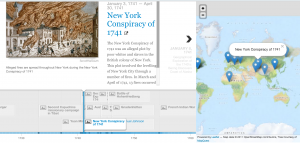History is a vital part of our existence as human beings. Not only does it tell our story for future civilizations, but history serves as a reminder of what is possible, and impossible. The saying, “history repeats itself” has been true a countless number of times. For this reason and more, it is vital to represent history accurately and efficiently; and with changing technology, there are often new, innovative ways to do so.
Many people are unfamiliar with the multitude of ways to represent time that are available today. The timeline seems so 1970’s when compared to what we can use now. In Grafton’s introduction, he states, “Our idea of time is so wrapped up in the metaphor of the line that taking them apart seems virtually impossible” (13), meaning that humans’ perspective on representing time is as narrow-minded as how we think of time in general. Most people, including myself, see time as linear when it is anything but, and also see representing time as single dimensional, when it is the opposite as well.

While compiling entries for Timemapper and Timeglider, I noticed that although Timeglider was a line, there were still ways to point out significant events. One could change the color of the font or make it larger to show the level of significance of an event. Timemapper was much more visual – using a map with key locations of historic events, a picture of the event and a brief summary.

Grafton also explains the flaws of representing history centuries ago, and the methods that were used back then. When explaining the Annals of St. Gall, he says, “Above the level of the year, there is no distinction among periods, and lists begin and end as nameless chroniclers pick up and put down their pens” (12). This further adds to the fact that with time, representing history has drastically improved. History in the medieval ages and even several centuries ago was much more obscured than it is today. Not only do we pride ourselves in the unbiased accuracy of events, but also in how we present them do the public.